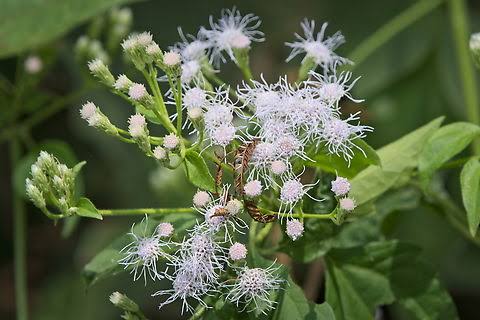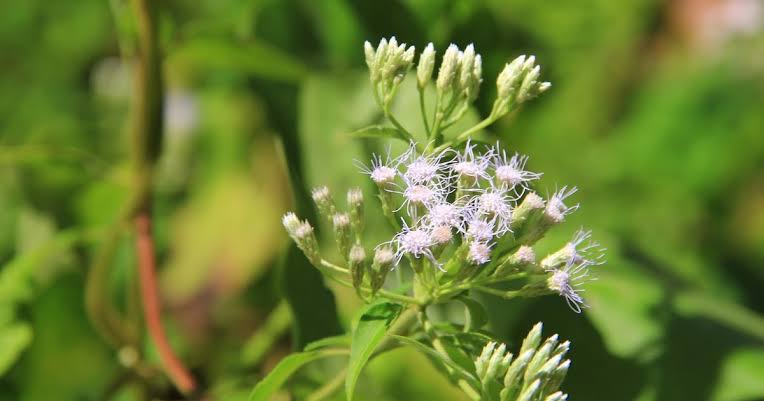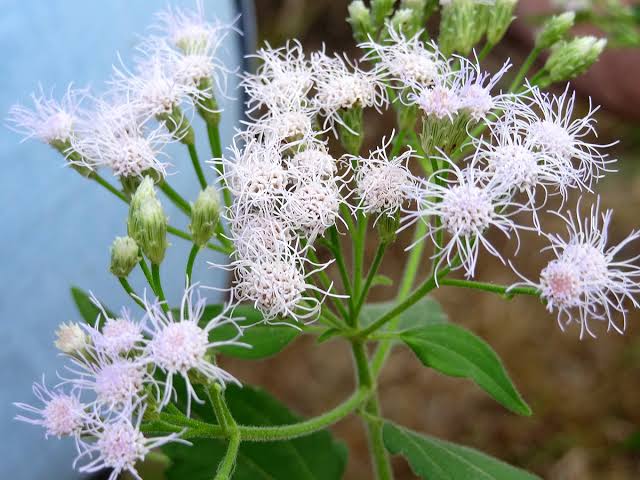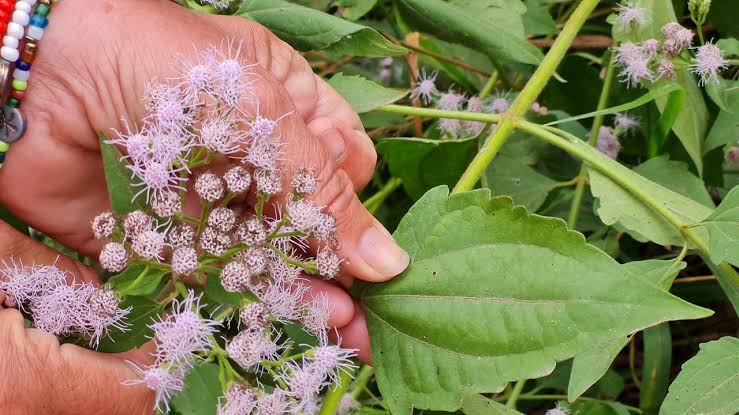Siam weed, scientifically known as Chromolaena odorata, is a perennial herbaceous plant native to tropical and subtropical regions of the Americas. It has gained prominence in various parts of the world, particularly in Southeast Asia, where it is often seen as both a useful plant and a troublesome invasive species.
The plant is characterized by its fast growth and adaptability to different environmental conditions, allowing it to thrive in disturbed areas, pastures, and even along roadsides. Despite its reputation as a weed, Siam weed boasts a range of beneficial properties that have attracted the attention of researchers, herbalists, and farmers alike.
One of the most notable features of Siam weed is its striking appearance. The plant can grow up to 2 meters tall, with broad, serrated leaves that emit a distinctive aroma when crushed. The flowers of Siam weed are small, white to pale lavender, and they bloom in clusters, attracting various pollinators, including bees and butterflies.
This vibrant display of flowers not only contributes to the aesthetic value of the plant but also plays a vital role in supporting local biodiversity. In traditional medicine, Siam weed has been used for centuries to treat various ailments.
The leaves, stems, and flowers are rich in phytochemicals, including flavonoids, terpenoids, and alkaloids, which contribute to its medicinal properties. These compounds have been found to possess anti-inflammatory, antimicrobial, and antioxidant effects, making Siam weed a valuable resource for natural remedies.
In many cultures, the leaves are prepared as poultices for wounds, cuts, and bruises, helping to promote healing and reduce inflammation. Additionally, the plant has been used to alleviate symptoms of respiratory conditions, digestive issues, and even fevers.
The health benefits of Siam weed extend beyond traditional uses. Modern research has begun to explore the pharmacological properties of this plant, revealing its potential applications in various fields, including medicine and agriculture.
Studies have indicated that extracts from Siam weed may have anti-cancer properties, with some findings suggesting that they can inhibit the growth of certain cancer cells. This promising avenue of research has sparked interest in further investigating the mechanisms behind these effects and the potential for developing new treatments based on Siam weed compounds.
In agriculture, Siam weed has been recognized for its ability to enhance soil quality. The plant’s deep root system helps prevent soil erosion, while its biomass can be used as organic matter to improve soil fertility.
Farmers in some regions have integrated Siam weed into their cropping systems, using it as a green manure or cover crop. This practice not only provides a natural source of nutrients but also promotes biodiversity by attracting beneficial insects and pollinators to the farm.
However, the aggressive growth habit of Siam weed has raised concerns in many areas, as it can outcompete native plants and disrupt local ecosystems. Its ability to thrive in various environments allows it to spread rapidly, often leading to significant ecological imbalances.
As a result, efforts to manage and control Siam weed populations have become a priority in regions where it poses a threat to native biodiversity and agricultural productivity. Despite its invasive nature, Siam weed’s versatility has led to various innovative uses.
In some communities, the plant is utilized for crafts and construction. The fibrous stems can be processed to create ropes, mats, and even biodegradable packaging materials. This sustainable approach to utilizing Siam weed demonstrates how communities can harness the potential of this plant while mitigating its invasive impact.
Siam weed also plays a role in traditional rituals and cultural practices in certain regions. In some cultures, the plant is considered sacred and is used in ceremonies to promote healing and protection.
The cultural significance of Siam weed highlights its deep-rooted connection to the traditions and beliefs of local communities, further emphasizing the importance of understanding and respecting its multifaceted nature. While the properties and benefits of Siam weed are impressive, it is essential to approach its use with caution.
As with any herbal remedy, individuals should consult healthcare professionals before using Siam weed for medicinal purposes, particularly if they have underlying health conditions or are taking medications. Additionally, responsible management practices should be employed to control its spread in areas where it poses a risk to native ecosystems.
Read Also: Health Benefits of Pawpaw Fruit
Health Benefits of Siam Weed: Traditional Uses and Remedies

This perennial plant, native to the Americas but widely spread in tropical regions, has become a significant part of traditional medicine and herbal remedies. The leaves, flowers, and stems of this plant are packed with phytochemicals, making it a valuable resource for treating numerous ailments. Here we explore the various health benefits and traditional uses of this remarkable herb.
1. Anti-Inflammatory Properties: One of the prominent aspects of this plant is its anti-inflammatory effects. Traditionally, it has been utilized to alleviate pain and swelling associated with various conditions. The leaves are often prepared as poultices and applied to inflamed areas, providing relief from conditions such as arthritis, muscle pain, and joint disorders.
By reducing inflammation, this herbal remedy aids in pain management and enhances the overall healing process. The anti-inflammatory compounds found in the plant can help mitigate the body’s response to injury, promoting quicker recovery and a return to normal function.
2. Antimicrobial Properties: In addition to its anti-inflammatory effects, the plant has been recognized for its antimicrobial properties. Traditional healers have long used it to treat wounds and infections. The juice extracted from the leaves can be applied to cuts, abrasions, and sores, helping to prevent infection and accelerate recovery.
The plant’s ability to inhibit the growth of bacteria and fungi has been supported by modern scientific research, confirming its historical use in promoting skin health. Studies have shown that various extracts from the leaves can effectively combat pathogens, making it a valuable addition to any first aid kit.
3. Respiratory Benefits: The respiratory benefits of this herb are also noteworthy. It has been employed in traditional medicine to relieve coughs, colds, and respiratory infections. Infusions made from the leaves are commonly consumed to soothe sore throats and reduce coughing. The plant’s expectorant properties help clear mucus from the airways, making it easier to breathe.
This use is particularly beneficial in regions where respiratory illnesses are prevalent, offering a natural remedy for those seeking relief. Additionally, its soothing effects on the throat can provide comfort during respiratory distress, making it a popular choice among traditional healers.
4. Digestive Health: Digestive health is another area where this plant shines. Traditionally, it has been used to address digestive disorders such as indigestion, bloating, and diarrhea. The leaves are often brewed into teas or consumed fresh to help stimulate digestion and improve gut health.
The herbal remedy’s ability to soothe the gastrointestinal tract and promote healthy digestion has made it a staple in many households. Moreover, its potential to regulate bowel movements and relieve constipation is highly valued, making it an essential component of traditional diets in certain cultures.
5. Immune Function Enhancement: Furthermore, this versatile plant is noted for its potential in enhancing immune function. The phytochemicals present in its leaves contribute to boosting the body’s defenses against infections and diseases.
Traditional medicine practitioners believe that regular consumption of herbal infusions can strengthen the immune system, helping the body ward off illnesses, especially during seasonal changes when colds and flus are common. The antioxidants found in the plant help neutralize harmful free radicals, reducing oxidative stress and promoting overall health.
6. Calming Effects: The calming effects of this herb are another aspect that contributes to its popularity. It has been used in traditional practices to relieve stress and anxiety. The aroma of the plant, particularly when used in teas or infused oils, is believed to have soothing properties that can help promote relaxation and enhance mood.
This calming effect is especially valuable in today’s fast-paced world, where stress management is crucial for overall health and well-being. Herbal preparations made from this plant can serve as natural alternatives to conventional anxiolytic medications, offering a gentle way to cope with life’s pressures.
7. Agricultural Benefits: In agricultural contexts, the plant is also recognized for its potential benefits. It serves as a natural pest repellent, making it an excellent companion plant for various crops. Farmers often incorporate it into their agricultural practices to enhance crop yields and maintain healthy ecosystems.
The ability to deter pests without the need for synthetic chemicals aligns with sustainable farming practices, making it a valuable resource for environmentally conscious farmers. Its use can promote biodiversity and soil health, further supporting sustainable agriculture.
8. Anti-Diabetic Properties: Emerging research has suggested that this plant may also possess anti-diabetic properties. Some studies indicate that extracts from its leaves can help lower blood sugar levels and improve insulin sensitivity.
This potential makes it an intriguing option for individuals managing diabetes or those at risk of developing the condition. By supporting healthy blood glucose levels, the plant could play a role in comprehensive diabetes management strategies alongside lifestyle changes and dietary adjustments.
9. Nutritional Value: In addition to its medicinal benefits, the leaves of this plant are also nutritious. They are rich in vitamins and minerals, including vitamin C, calcium, and iron.
Incorporating these leaves into the diet can contribute to overall nutritional health, providing essential nutrients that support various bodily functions. The nutritional profile further underscores the value of this herb as a dual-purpose resource—both as a food source and a medicinal remedy.
10. Cultural Significance: The cultural significance of this plant cannot be overlooked. In many regions, it holds a place in traditional rituals and practices, symbolizing healing and resilience.
Its integration into local medicine showcases the deep connection between communities and their natural environments. As interest in herbal remedies grows, the cultural heritage surrounding this plant continues to be celebrated, ensuring that traditional knowledge is passed down through generations.
While the traditional uses of this plant are extensive, it is essential to approach its application with care. Individuals considering its use for medicinal purposes should consult with healthcare professionals, especially those with pre-existing health conditions or who are pregnant. Although generally regarded as safe, it is vital to ensure that the plant is used correctly to avoid any adverse effects.
Read Also: Health Benefits of Ugu Leaf
Preparation and Consumption: How to Use Siam Weed for Optimal Health

1. Herbal Tea: One of the simplest and most effective ways to enjoy the benefits of Siam weed is by making herbal tea. To prepare this soothing infusion, fresh leaves should be harvested and thoroughly washed to remove any dirt or impurities.
After cleaning, chop the leaves into smaller pieces to increase the extraction of their beneficial compounds. Pour boiling water over the chopped leaves and let them steep for about 10 to 15 minutes.
For added flavor, the tea can be sweetened with honey or flavored with lemon. This herbal infusion is ideal for relieving digestive issues, respiratory ailments, or inflammation, making it a versatile option for daily consumption.
2. Poultice Application: Another effective method for utilizing Siam weed is through poultice application. This preparation involves crushing or blending fresh leaves into a paste and applying it directly to inflamed or sore areas of the body, such as joints or wounds.
The anti-inflammatory and antimicrobial properties of the herb make it effective for reducing swelling and preventing infections. To use this method, secure the poultice with a clean cloth and leave it on for several hours or overnight. This application not only provides localized relief but also promotes healing in affected areas.
3. Cold Infusion: For those seeking a milder way to enjoy the health benefits of Siam weed, creating a cold infusion is an excellent option. This method involves soaking fresh or dried leaves in cold water for several hours or overnight.
This gentle extraction method preserves some of the plant’s delicate properties and provides a refreshing drink. The resulting cold infusion can be consumed throughout the day, offering hydration along with the herb’s numerous health benefits. This preparation is particularly beneficial in warmer climates, where a cool beverage can provide relief and refreshment.
4. Culinary Uses: Incorporating Siam weed into meals is another excellent way to enjoy its health benefits while adding flavor to dishes. The leaves can be added to soups, stews, or stir-fries, contributing both nutrition and unique flavor.
It’s advisable to add the leaves toward the end of the cooking process to preserve their nutritional value and medicinal properties. This culinary approach not only enhances the taste of meals but also allows individuals to reap the health benefits of the herb seamlessly within their diet.
5. Dosage Considerations: When consuming Siam weed, moderation is key. While it is generally safe for most individuals, excessive amounts may lead to digestive discomfort or other adverse effects. A practical guideline for enjoying the herb is to drink one to two cups of herbal tea per day or use the leaves in cooking as part of a balanced diet.
For poultices, applying as needed to affected areas provides relief without overwhelming the body. It’s crucial to listen to one’s body and adjust consumption based on individual tolerance.
6. Consultation with Healthcare Professionals: Before incorporating Siam weed into a health regimen, individuals taking prescribed medications should consult healthcare professionals.
This precaution ensures that using the herb does not interfere with ongoing treatments or exacerbate existing health issues. It is especially important for individuals with pre-existing conditions, pregnant women, and those with allergies to be cautious, as herbal remedies can interact with conventional medications.
7. Agricultural Benefits: In agricultural settings, Siam weed is beneficial as a natural pest repellent. Farmers often plant this herb alongside crops to protect them without relying on synthetic chemicals. This sustainable practice not only enhances crop yields but also contributes to healthier farming practices.
By utilizing Siam weed as a companion plant, farmers can maintain healthy ecosystems while reducing the environmental impact of conventional pest control methods. This use of the herb highlights its versatility beyond medicinal applications, showcasing its role in promoting agricultural sustainability.
8. Aromatherapy Uses: The aromatic qualities of Siam weed make it suitable for use in aromatherapy practices. Dried leaves can be used in potpourri or infused into oils for massage. The calming properties of the herb can help reduce stress and promote relaxation, making it an excellent addition to wellness routines.
When used in aromatherapy, the plant’s scent can create a tranquil environment, enhancing overall well-being. Incorporating Siam weed into relaxation practices, such as meditation or yoga, can provide additional benefits, contributing to a holistic approach to health.
9. storage and Preservation: For those interested in using Siam weed regularly, proper storage and preservation methods are essential to maintain its potency. Fresh leaves should be used promptly, but if you need to store them, it’s best to keep them in a cool, dry place away from direct sunlight.
Alternatively, the leaves can be dried and stored in airtight containers to preserve their medicinal properties. Dried leaves can be rehydrated for use in teas or poultices, ensuring that the health benefits remain accessible year-round.
Frequently Asked Questions on the Health Benefits of Siam Weed

1. What are the primary health benefits of Siam weed?
Siam weed, or Chromolaena odorata, is renowned for its various health benefits, including anti-inflammatory, antimicrobial, and antioxidant properties. It has traditionally been used to alleviate pain, treat wounds, improve respiratory health, aid digestion, and enhance immune function. Additionally, it may provide calming effects, making it useful for stress relief and relaxation.
2. How can I prepare Siam weed for medicinal use?
Siam weed can be prepared in several ways, including as an herbal tea, poultice, or cold infusion. To make herbal tea, steep fresh or dried leaves in boiling water for 10 to 15 minutes. For a poultice, crush fresh leaves and apply them to sore or inflamed areas. Cold infusions can be made by soaking leaves in cold water for several hours, creating a refreshing drink that preserves some delicate properties.
3. Are there any side effects or precautions to consider?
While Siam weed is generally considered safe, moderation is crucial. Excessive consumption may lead to digestive discomfort. Individuals taking prescribed medications or those with existing health conditions should consult healthcare professionals before using Siam weed to avoid potential interactions or adverse effects.
4. Can Siam weed be used in cooking?
Yes, Siam weed can be incorporated into meals to enhance flavor and nutrition. The leaves can be added to soups, stews, or stir-fries. It’s best to add them toward the end of the cooking process to preserve their nutritional value and medicinal properties. This culinary use provides a delicious way to enjoy the health benefits of the herb.
5. How does Siam weed support immune function?
Siam weed contains various phytochemicals that may boost the immune system. Regular consumption of the herb, whether through tea, culinary use, or other preparations, may help the body fend off infections and diseases, particularly during seasonal changes when colds and flus are more common. Its traditional use in enhancing immunity underscores its importance in holistic health practices.
6. What forms of traditional medicine use Siam weed?
Siam weed has been utilized in various forms of traditional medicine, including herbal infusions, poultices, and topical applications. In many cultures, it is used in conjunction with other herbs to create comprehensive treatments for specific ailments. Traditional healers often incorporate this herb into remedies for respiratory issues, skin infections, and digestive disorders.
7. Can Siam weed be beneficial for skin health?
Yes, Siam weed has demonstrated antimicrobial and anti-inflammatory properties that can be beneficial for skin health. Its leaves can be used topically to treat wounds, cuts, and skin irritations.
The juice extracted from the leaves is often applied to the affected areas to prevent infection and promote healing, making it a valuable natural remedy for various skin conditions.
8. How can I store Siam weed for later use?
To store Siam weed for later use, it’s best to dry the leaves in a shaded area to preserve their potency. Once dried, the leaves can be stored in an airtight container in a cool, dark place.
Dried leaves can be used to make herbal tea or incorporated into cooking as needed. Proper storage helps maintain the herb’s effectiveness and extends its shelf life for future use.
Read Also: Soya Milk: Nutrition, Facts and Health Benefits
Do you have any questions, suggestions, or contributions? If so, please feel free to use the comment box below to share your thoughts. We also encourage you to kindly share this information with others who might benefit from it. Since we can’t reach everyone at once, we truly appreciate your help in spreading the word. Thank you so much for your support and for sharing!

